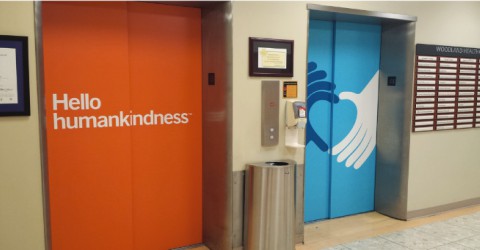
The elevators at Dignity Health Medical Foundation help tell their story.
What is your organization’s STORY? Do you know it? Could you tell it in 60 seconds or less to a stranger on the street?
Do your employees know what that story is on a daily basis? I’m not talking about just listening to the business owner or the CEO kick off New Employee Orientation by telling you the organization’s history, mission, vision, and values. I’m asking you to think about how you see the STORY of your organization come to life every day by everything you see hear and touch.
Can you walk down the halls and see your story in the artwork on the walls or in customer waiting areas? Does it come to come to life in the way patients are checked in, or in the kind of name tags and uniforms your employees wear, or in the language they use?
Dignity Health Medical Foundation uses their physical surroundings to help tell their story, which is “We unite healing and humankindness.” It’s on their elevator doors, parking lot signage, and throughout their facilities as a reminder to patients, visitors, and employees of what they stand for and who they are as a healing organization.
Look inside your executive board room. Is the mission on the wall? Is the room itself named after one of your founders, or perhaps a respected member of your community, or a virtue or value you or the organization holds up as a competitive advantage?
If not, you have some work to do. Why? Because if you don’t tell your story in an intentional and meaningful way, it will get told by default.
If your employees don’t know your story, then they don’t know WHY your business exists. And if employees don’t know the “WHY” or your purpose then they cannot be brand managers for you and share that story with their friends, family, or local community.
Many organizations are just a hodgepodge mosaic of departments and silos doing their own thing. They aren’t intentional or thoughtful with the story they’re telling.
Remember, the customer (and patient) experience is comprised of more than just the product or service you sell; it is reflected through your organization’s people, processes, product and physical environment.
If there’s no storyline that runs through those four elements, you may be unintentionally confusing your customers into thinking there is no consistency, continuity or common thread that unites us.
In short, when you have no storyline, you have inconsistency, confusion, and hundreds of employees just making it up as they go.





